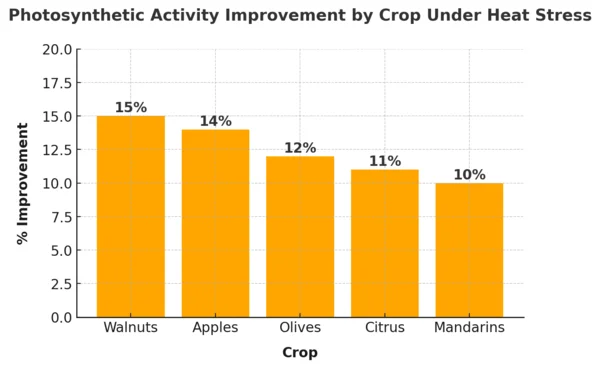Rethinking orchard heat protection: How bio-based coatings are changing the equation
Protecting orchard crops from sunburn isn’t new. What’s changed is the intensity of heat events and the urgency for sustainable protection methods. For decades, growers have relied on shade nets, kaolin clays, and liquid calcium carbonate coatings. Today, starch-based reflective coatings like Cropshader are reshaping this landscape — combining effective heat reduction with plant-friendly and biodegradable performance.
With global fruit orchards spanning over 53 million hectares and producing 887 million tonnes annually, even a small percentage of sunburn loss represents billions of euros in lost value each year.
Comparison to Kaolin and other liquids
| Features | Cropshader | Other liquid Calcium Carbonate | Kaolin Clays |
| Content | Combination of different white reflective pigments and Lumiforte’s starch technology. Extra white appearance. | Main ingredient is calcium carbonate. White appearance. | Main ingredient is aluminium silicate. Yellowish appearance. |
| Wear resistance | High wear resistance (≈130 mm rainfall in 3 months in the Netherlands on pomegranate leaf). | High-medium wear resistance (depends on surface, climate, and binder amount). | Low-medium wear resistance. |
| Bio based content | Starch-based biobased binding system; 93% of raw materials are from natural origin (ISO 16128). Does not contain or cause microplastics. | Typically synthetic/acrylic binding system. Microplastic concerns. | Typically synthetic/acrylic binding system or no binder. Microplastic concerns. |
| UV & Infrared protection | Reflection of PAR & IR radiation equally. Higher UV-A & UV-B reflection. | Reflection of PAR & UV & IR radiation equally. | Reflection of PAR & UV & IR radiation equally. |
| Photosynthesis impact | Trials on apple, mandarin, olive, orange, walnut, and pomegranate show that Cropshader increases photosynthetic activity by mitigating solar stress. | No data available. | Some reports suggest increased photosynthesis, but kaolin is less white and reflective overall. |
| Biodegradability | “Readily biodegradable” according to OECD 301F guideline. | Not considered readily biodegradable. | Not considered readily biodegradable. |
| Registration | Registered in the EU as a plant biostimulant with proven trials against abiotic and solar stress. | Either registered as fertilizer or sold without registration, which limits export opportunities. | Usually imported as an industrial material, not agricultural — making import/export processes relatively easier but limiting agronomic application. |
Why a starch-based coating stands out
- Bio-based & biodegradable: 93% natural origin (ISO 16128) and fully biodegradable (OECD 301F).
- Certified plant biostimulant: CE-marked under Regulation (EU) 2019/1009, PFC 6(B) Non-Microbial.
- Sustained photosynthesis: Protects leaf function during heatwaves by reducing solar stress without blocking stomata.
- aField-proven performance: Trials on apples, walnuts, olives, mandarins, oranges, and pomegranates show up to 6.1 °C temperature reduction and up to 15% higher photosynthetic activity.

*Cropshader Orchard increased photosynthetic activity by up to 15% under heat stress across multiple crops, helping trees maintain energy production during the hottest periods.
Alternative Cooling Solutions — Shade Nets and Irrigation
Other orchard heat-protection methods exist, such as shade nets and evaporative cooling through irrigation. While shade nets can indeed protect against hail and strong winds, they involve high installation and maintenance costs and can reduce light transmission, potentially lowering yield quality. Irrigation-based cooling, on the other hand, requires large water volumes and pumping energy, making it unsustainable in regions with water scarcity.
When the objective is reflecting solar radiation and cooling the canopy, Cropshader provides a simpler, more scalable, and cost-efficient solution. It can be applied directly with standard sprayers, offering immediate protection without infrastructure investment.
The Takeaway
The right heat-protection strategy balances cost, crop physiology, and sustainability. While nets and cooling systems serve niche functions, Cropshader stands out as the next-generation natural film — combining durability, biodegradability, and photosynthetic enhancement.
It’s a microplastic-free, EU-certified, and field-proven alternative to traditional mineral coatings — ideal for both smallholders and large-scale export orchards seeking sustainable, regulation-compliant protection.